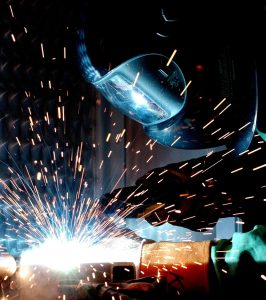CTE and CBE: A Blueprint for High-Quality Instruction
CompetencyWorks Blog
Our educational system was designed for an industrial generation of the past. Current students generally struggle to see the relevance of school, which has led to more disengagement, lower standardized test scores, and higher dropout rates. Career and technical education (CTE) and the use of competency-based learning can alleviate some of these issues. While we live in the most stimulating time in the history of the world, we, as educators, struggle more with student engagement than ever before. Schools should look in their CTE classrooms to see the blueprint of how competency-based education (CBE) can be achieved to create relevant and engaging learning.
So Why Competency-Based Education (CBE)?

An English teacher assigns a compare and contrast essay between Ralph Waldo Emerson’s essay Self-Reliance and Henry David Thoreau’s Walden to his junior English class. Immediately, there is a collective groan from the class. The day before it is due, the teacher reminds his students that he will collect their essays tomorrow. From the back of the room, a student subtly comments that he has not even started it and plans to write it in the class before. Only about three-quarters of the class turns in the essay on the due date. The teacher is obviously frustrated but hopes that more students will turn it in the following day. Unfortunately, only one or two more essays reach his desk. No one asks about the essays until the teacher finally finishes painstakingly reading every misspelled word, split infinitive, and passive voice. He writes detailed critiques of each and offers suggestions on improving their syntax and analysis. After passing out the graded essays and asking for comments, no student even moves to raise their hand. Most of the essays end up in the trash at the end of the day, despite all the time and effort the English teacher spent working to improve his class’s writing.

Meanwhile, in the welding classroom, the welding teacher gives instructions on how to make a basic flat weld. The students eagerly put on their safety equipment and attempt the task at their welding stations. The welding instructor rotates from station to station, supervising student performance and safety. Once the first student finishes, he runs to the teacher to proudly show the fruits of his labor. “Does this look good? I mean, is it right?” he asks. The welding instructor gives him some pointers on how to improve the structure of the weld and the student rushes back to try it again. After the second attempt, the instructor congratulates the student on a job well done and presents him with a certificate of certification the student can keep, showing this student can perform this type of weld in the “real world.”
These two situations play out every day in classrooms across the United States. In the English room, many students struggle to connect the assignment to any real-world application. They dread the writing, are not receptive to feedback, and fail to put forth their best effort. In the welding classroom, most students are eager to practice their learning. They actively seek feedback from the instructor and are open to reattempting the technique until they have perfected it. They know they will get something tangible at the end of the process that shows what they have mastered and what they learned can be transferred into real-world career opportunities culminating in a paycheck. This is the power of mastery-based or competency-based learning, which is often found in a CTE classroom.
CTE IS Competency-Based Learning!
Nearly all of the seven components of Aurora’s definition of competency-based learning can be found in a CTE classroom. While they can also be found in core classroom instruction, in practice, they typically are not. Carri Schnieder states, “One system that has often been overlooked in conversations about competency-based pathways has been that of career and technical education. CTE promotes personalized learning and real-world application – both fundamental tenets of a competency-based approach.”
In the welding classroom, for example, students can demonstrate their learning through an end product created through project-based learning. Students find the assessments meaningful and relevant to the real world and receive support from the teacher exactly where and when they need it. There are clear expectations for what mastery looks like. Once achieved, students are celebrated (often through a certificate of proficiency or an industry-based certification that can be directly applied in the workforce) and can advance to the next skill. Suppose these components could be applied in the English classroom. In that case, students may find the essay assignment more relevant and become what Dr. Phillip Schlecty called in his book Leading for Learning “authentically engaged” in their learning instead of just being strategically compliant.
Competency-based education through CTE and beyond is even more critical as many companies are moving away from degree hiring and toward skills-based hiring. In 2023, SHRM reported that 76% of companies say they are using a skills-based hiring system. A movement called “Tear the Paper Ceiling” even advocates that more companies use skills-based hiring. Therefore, schools must ensure students possess the necessary skills to enter college or the workforce. This extends beyond the CTE classroom and into core academic areas. Schools can accomplish this by setting clear and transparent learning goals for students that align with local industry needs and utilizing meaningful assessments. For example, Arkansas recently required all high schools to offer at least one CTE program that meets the H2 (high-demand and high-wage) designation.
Learning from CTE

High schools nationwide should consider adopting a competency-based approach to education; an example of this can be found in their CTE buildings. In a CompetencyWorks post a decade ago, Brian Stack states that in the world of CTE, holding students accountable for their learning and assessing their mastery of course competencies is nothing new. In fact, in most CTE programs performance and the product are everything! Fortunately, ample resources and rubrics are available for schools or teachers who want to utilize this relevant approach in the core curriculum.
Aurora’s seven evidence-based design principles are the framework for implementing competency-based learning. In Arkansas, the Office of Innovation for Education worked with the New Hampshire Learning Initiative and competency-based learning expert Jonathan Vander Els, co-author of the 2022 book Unpacking the Competency-Based Classroom, on best practices for schools that wish to utilize this approach.
The Winthrop Rockefeller Institute, through its Education Policy Initiative, also held focus groups, policy maker panels, developed a one-pager for legislators, and took a long look at schools attempting competency-based learning throughout the state. Greenbrier High School is a prime example of a school moving towards competency-based education. Currently, they utilize standards-based grading up through 9th grade with plans to expand it throughout the high school. To better understand how to develop rubrics that ensure students meet the standards in place, they turned to their CTE teachers. They already use these rubrics daily, exhibiting design principle number seven: rigorous, common expectations for learning (knowledge, skills, and dispositions) that are explicit, transparent, measurable, and transferable.
The CTE-CBE Blueprint can Advance Education!

If we change the system to make learning more relevant to students and tie it into real-world applications, perhaps students would re-engage with schools. Van Griethuijsen et al. in 2019 concluded, “The level of CBE implementation is positively associated with student satisfaction with the quality of education and guidance. Education that is more competence-based in nature is, thus, rated more positively by students in terms of quality and guidance the students receive.”
Competency-based learning can help bring education into the 21st century by giving students agency over their own learning, empowering students to use their learning outside of the classroom, honoring the unique contributions of students and the knowledge they bring from their diverse backgrounds, and utilizing innovative assessments such as project-based learning, demonstrations, or portfolios the way that many CTE teachers already do. By ensuring students have the skills necessary to enter college or the workforce, schools can better engage students, ultimately leading to students finding more relevance in their schooling experiences.
Learn More
- Innovation in New Mexico: Bringing Work-Based Learning to Scale at ACE Leadership High School
- Elevating Student Voice: Reflections From Across the U.S.
- It’s Time to Level the Post-Secondary Playing Field: Six Principles for Building a Career Pathways Program
 Aaron Duvall is dedicated to creating a paradigm that enables all students to succeed. He is deeply passionate about connecting underserved and underrepresented students with life-changing opportunities through career and technical education and driving systemic change in the educational system through competency-based learning. Aaron Duvall is the former CTE Director for Responsive Education Solutions of Arkansas, a charter school organization taking an innovative approach to education by creating nontraditional pathways for students and specializing in personalized, mastery-based learning for marginalized students. Duvall is currently pursuing his Ed.D. in Rural and Diverse Education as a member of Southern Arkansas University’s inaugural cohort. He earned his Master’s in School Leadership and Management from the University of Central Arkansas. He graduated summa cum laude from UCA for his bachelor’s degree, where he was named Student Teacher of the Year. He resides in Conway, Arkansas, with his wife, Kim; sons, Gabe and Everest; and daughter, Emerson. In his free time, he enjoys traveling, reading, gardening, and taking family walks with his Great Pyrenees tagging along.
Aaron Duvall is dedicated to creating a paradigm that enables all students to succeed. He is deeply passionate about connecting underserved and underrepresented students with life-changing opportunities through career and technical education and driving systemic change in the educational system through competency-based learning. Aaron Duvall is the former CTE Director for Responsive Education Solutions of Arkansas, a charter school organization taking an innovative approach to education by creating nontraditional pathways for students and specializing in personalized, mastery-based learning for marginalized students. Duvall is currently pursuing his Ed.D. in Rural and Diverse Education as a member of Southern Arkansas University’s inaugural cohort. He earned his Master’s in School Leadership and Management from the University of Central Arkansas. He graduated summa cum laude from UCA for his bachelor’s degree, where he was named Student Teacher of the Year. He resides in Conway, Arkansas, with his wife, Kim; sons, Gabe and Everest; and daughter, Emerson. In his free time, he enjoys traveling, reading, gardening, and taking family walks with his Great Pyrenees tagging along.